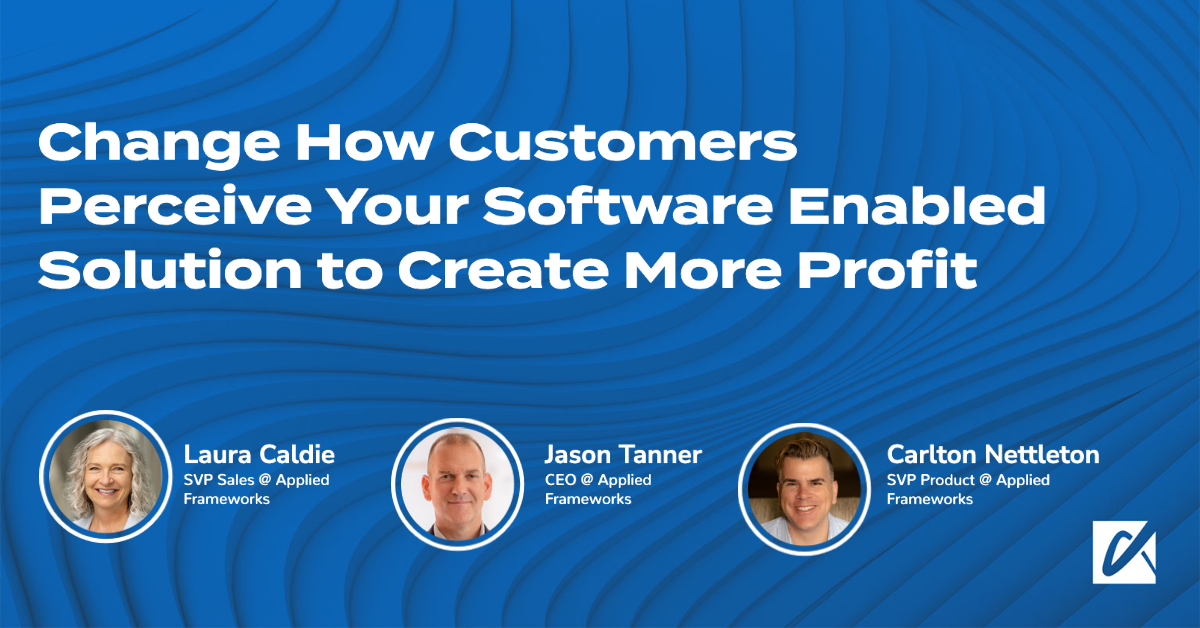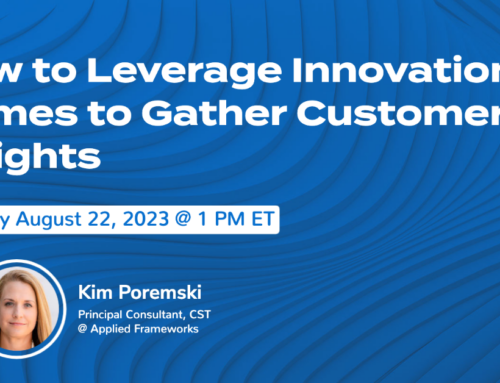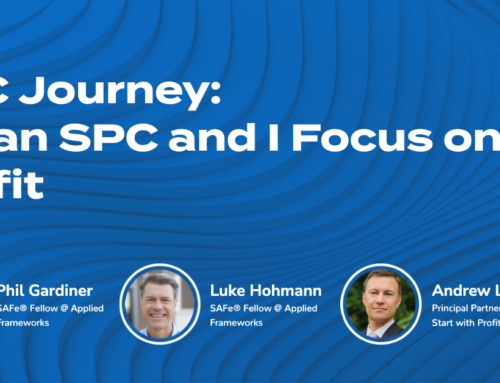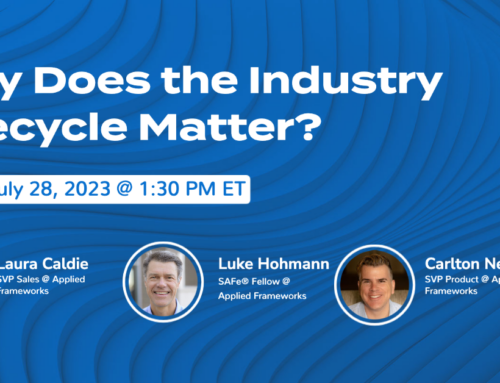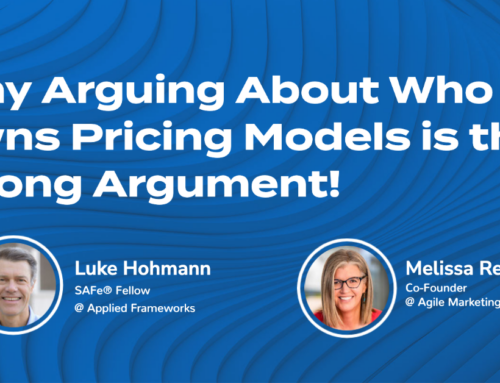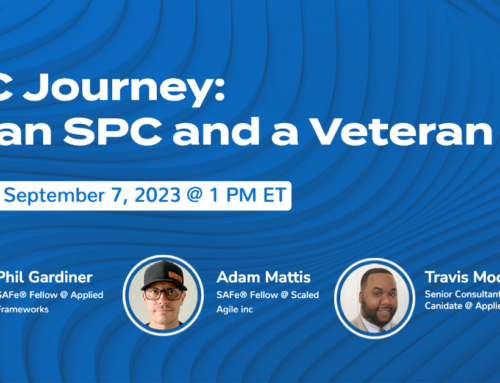Product Management Minute Episode 2| Recording
In our last webinar, Laura Caldie talked with the instructors of the Profitable Software Academy Jason Tanner, and Carlton Nettleton about about ways to quantify value and the importance of intangible value. In the next episode recorded live on July 7, 2023, they will explored the power of two frameworks that can help product leaders and teams improve the profitability of their solutions.
Attend if you want to:
- See how a Solutions Benefit Map can unlock profit
- Learn about Whole Product Thinking to shift the way your customers perceive your solution
Recording | Presentation
About the Series
Jason Tanner and Carlton Nettleton dive quickly into product management topics in this series of short, immediately useful webinars. Topics discussed come directly from the feedback we hear from graduates of the Profitable Software Academy, a program supporting the professional development of product managers at all levels of their careers.
Check Out Past Episodes
About Jason Tanner
Jason is the CEO of Applied Frameworks, author of Software Profit Streams™ A Guide to Designing a Sustainably Profitable Business, and an instructor in the Profitable Software Academy, delivering timely, high-impact support for our largest clients who have hundreds of members of the academy learning the latest approaches to building profitable solutions.
About Carlton Nettleton
Carlton is the SVP of Product at Applied Frameworks and a Certified Scrum Trainer recognized for designing engaging courses for professionals building amazing Software Enabled Solutions across multiple industries. As an instructor in the Profitable Software Academy, he has a front row seat in helping participants tackle all the tricky but energizing problems product managers face as they guide the development of the solutions they manage.
Transcript
*transcribed using otter.ai. Please excuse any grammar and spelling mistakes
Laura Caldie 00:12
Hi there, Jason. Hi, Carlton. How are y’all doing?
Carlton Nettleton 00:16
Great. Happy Friday.
Laura Caldie 00:17
Happy Friday to you do I am excited about this topic looking forward to it. So we’ll give people a few minutes to trickle in. And then we’re recording it So for folks who can’t make it, we will share the recording out and and go from there. But again, the whole idea here is how much can we learn in a short amount of time and if we do this regularly, I think there’s going to be a lot of goodness that comes out of it. All right. Okay, so topic of the day is, how do your customers perceive your software right in a way that supports profitability? So, just to recap why we’re doing this product managers have the best job in the whole world. They get to build the coolest stuff, and they get to have a lot of influence over the neatest things. And so we all want to build something that our customers love and they’re willing to pay for and then they talk about how happy they are. So that’s, that’s who product people really are. And the environment in which they operate is just complicated. A lot of collaboration has to happen. There’s a lot of stakeholders that are involved. And so this kind of ping pong in between strategy and tactics in different areas of the organization. It just, it’s kind of the life of the product manager. So there’s a lot going on. That’s why we’re doing this series here is to pick up some of the really cool topics that make this job either crazy making or really fun and awesome and energizing. So hopefully we take that crazy and turn it into something that that people can tackle and get their hands around. So it’s about every three weeks or so I get to talk to Jason and Carlton and maybe we’ll even have some other guest speakers. But these two colleagues of mine are kind of core developers of the content in the profitable software Academy and because they built a lot of the content and because they get to interact with students in the program. We’re learning very quickly, based on the questions that we get or the questions that you get and the successes that some of our students are having. What are good topics to talk about and share more broadly. So the profit on software Academy is a kind of career supporting education program and that means you guys get a lot of opportunity to to hear from students about what’s working and what are they struggling with, and what are the successes. So with that, let’s dive into the topic. And Jason, I will turn it over to you.
Jason Tanner 02:51
All right. Thank you for the introduction. So hey, everyone, whether you’re watching live or the recording I really want to focus on value and what to do with what we talked about last time, when we define value and the idea of value is the benefits that customers receive lesser total cost of ownership, both the price of the software solution that they purchase, and all of the ongoing costs to maintain and administer, manage, upgrade, train other people how to use the software and so on now goes into TCO. And in the last session, we talked about these benefit cards. And one key point about these benefit cards that I think it’s really important is that we’re focusing on customer segments receiving the benefits of the solution. And I bring that up because it’s easy to misinterpreted and misinterpreted benefit card is a benefit to us. What’s our benefit if we do that if we build this feature? What do we expect to happen for us as a solution provider instead of thinking about okay, if I provide a solution that helps someone, save time or save a trip to the pharmacy, meaning I’m spending money on gas well as a customer benefits, these are always in the context of the dimension and magnitude of the benefit for a customer. So we want to extend that today and talk about what to do with these cards. And that is a solution benefit map. So I’ve taken a few key concepts out of the software profit streams took to really zero in on this idea of using the map from our benefit analysis we talked about last week to then identify what are the features that can best meet these needs of this specific customer segments. So this really helps us to figure out the packaging and the solution for different segments, because I can provide the same solution in a different package to one segment and for another so I may have a basic segment customer segment only needs a basic solution, or I may have a completely different segment that needs a whole lot more capabilities and is willing to pay a higher price for that. And it also allows me then to identify what are the gaps? Where am I potentially exposed because my competitor may have an aspect of a solution delivery benefits and I don’t have and now allow me to then decide whether I want to respond to that. So that’s the whole point of the map. So what is a map look like? Well, simply take the cards that will be identified. In the last webinar, we take our benefit cards, we start putting them together, like what is the collection of benefits that a feature can deliver. That’s really one way we really want to frame the idea of what our features features are vehicles by which we deliver value through the benefits that we offer. So, Carlton, what else would you have to add here? Yeah, just a solution maps?
Carlton Nettleton 06:00
Yeah, I got two questions because this kind of came up recently. For for us one was the suit said You know, it was ones that are the question marks. What do they do with those items that are in the question mark category. I mean, that one’s the X category, you know, waste kind of obvious, right? But what do you do with the ones in the question mark?
Jason Tanner 06:24
That’s the first question is whether or not it is already on the roadmap or in a backlog is not identified a potential feature that is important to a segment is doing added to the roadmap. And with that in mind, how important is it to start getting feedback on adding to the roadmap sooner rather than later? Is this a vital feature that we really want to deliver the next release and we should jump on in immediately because it’s an important opportunity or isn’t interesting? We can defer it because there’s other high priority work that we need to do first.
Carlton Nettleton 07:02
Okay. Oh, and other question was, Is this similar to any other that exists, that product managers might be currently using to those individuals trying to connect it to something that they were doing in their day to day, this benefit map,
Jason Tanner 07:20
I think definitely connects to roadmaps for sure. Because when we talk about roadmaps and adding items to roadmap, not only do we put the card with a feature on it, we tend to list the benefits. So this would absolutely contribute directly into a roadmap. And I also believe that could be also associated into a story map. I think about the whole walking skeleton backbone of a story map. I’m actually starting to identify the essential features I might as well tag the benefits identified into segments to which they apply. Across the story maps. You can imagine the sort of vivid, multicolored story map where identify what’s important to different segments and the benefits of you’re expecting from the solution.
Carlton Nettleton 08:05
by amplifying story now, that’s a nice idea. Clever.
Jason Tanner 08:12
So here’s just a quick example showing how on the left, we have two different segments. There’s a whole series of benefits that they’re expecting in the mapping of those features so you can see it actually can allow a visualization of how you intend to serve multiple segments with a collection of features because as you can see, here, I’ve got a feature is valuable to different sites, the same segments. Likewise, this feature here valuable to both segments, and this I think, will actually help us to think about when we get into some future topics around pricing. And thinking about packaging and profit engines enables some differentiation of the solution which allow me to offer the solution at different price points, which is obviously maximize profitability. That’s all there like the idea of the profit stream Canvas being a system really starts becoming clearer here when we start doing this kind of detailed mapping. So the other aspect of this thing is the whole product framework and we really liked this framework because Ted live in. Theodore Levitt has written not only some great shorter articles for the Harvard Business Review, but one of the classic books on marketing that I really enjoyed reading is the marketing imagination where he really introduced this notion of the whole product and what it really means and some people may be familiar with it. But this notion of generic expected augmented potential product is really the essence of what he brings to, I’d say, a really useful lens or framework for thinking about expectations or product. So Carlton,
Carlton Nettleton 09:58
yeah, I was gonna say this is kind of one of my favorite frameworks. I’ve read that article at the Harvard Business Review. It’s a very good read. And it really kind of helped set the stage for how to understand how to use this framework. And what I like about this visual representation is it kind of helps you think as a product manager, how your product needs to grow over time, and what sort of capabilities or features you need to provide and one of the things I actually sometimes I learned from working with our students, is sometimes they have a little trouble trying to understand that generic product, like what does that fundamental thing that the solution needs to do to satisfy the customer right? And then you get and oftentimes what they do is they take a lot of things that are in the expected range and they put it into generic, right, like, and I often say you need to pull those out. Right, those are those are when you general solution, right? And then you start to think about the specific things that people expect. So I like to use mobile phones. That is a good example because they’re very easy to understand. So a mobile phone, a smart phone. It’s it is an information device. That’s the generic solution, but it can also do phone calls. It also connects to the internet. Those are some expected things that that you would expect are unique now today expect that it can be extensible by adding new applications to it. But then, you know, then you start really thinking about the augmented array and the potential rank is where really where the fun stuff starts to happen for product managers, because if most of what’s in your solution is all unexpected, you’re really just building this knee to product. And sometimes that’s where product managers are like, Hey, we’re behind the ball, the competition’s got ahead. We’ve decided we want to we want to compete in this space. So you got to fill out that expected ring. But the the augmented ring is how you start to differentiate. Right? It’s to to your strengths as a company and organization. And then the potential ring is how do we attract in new customers or new segments or new markets or hold on to existing customers? And sometimes I find some product managers or maybe focus a lot on the expected rain, right because they’re, you know, sometimes I get this way myself because I’m busy. Or they get into the augmented right they understand the differentiators. They don’t think about the augmented that are the potential which is how do we grow and how do we keep pushing that boundary? Well
Laura Caldie 12:34
I’m gonna I’m just going to interrupt here because we have another webinar coming up with the same team around the industry lifecycle and I’m certainly seeing the relationship you know, the big system where the augmented and potential product is very much related to the understanding of things like the industry lifecycle. And so this a little foreshadowing to what’s coming in the next webinar, but I think as we pull these together, we really are trying to connect the dots of the system and the clues little chunks of this. So this is great.
Jason Tanner 13:08
I think it highlights the difference between new product development and the solution lifecycle versus existing solution. So this is a framework that needs to be updated. It’s a living framework, because the competition is changing what is a differentiator today becomes part of the expected product tomorrow and there’s emerging technology. There’s new needs identified by customers. And we have to think about the future benefits that are going to be required by customers, which will then allow us to get a step ahead. All of this combines together to be a growing, living, breathing framework that actually allows us to think about the future and in creative ways. Yeah. So as you put these together, this really allows us to think about the way that we can actually create these solutions to create the economic opportunity. That’s where we get to the actual profitable solution. We can take the benefit maps with the whole product of thinking and then think about, okay, what is the expected solution we actually are going to deliver either it’s, or there’s version one or version four. We’re continuing to increase the quality of what we’re going to deliver. We’re continuing to serve different segments and satisfy their needs, and then also achieved parody neutralized competition competition, achieved the same level of performance as them and then we get into the killer features this may allow us to unlock a really is the one feature that provides the vast majority of the value. And there’s a couple of examples there. Uber figma. Who knows what it might be for your solution, it might be you know, the ease of reordering and there’s nothing like the one click ordering from Amazon. I don’t know if that’s our killer feature, but it sure is nice.
Jason Tanner 15:08
any questions from the audience? We’re right at the 15 minute mark your alarm?
Laura Caldie 15:11
That’s what I want. I figured everyone can find 15 minutes. So if there are any questions stick them into the q&a. Otherwise, if you have questions you think about afterwards, you’re welcome to send me an email and we can either weave them into the next one, weave it into our follow up email, or maybe it’s even a question that warrants its own 15 minutes and then while we’re just making sure all questions are answered, If you want to flip to the next one, we have an upcoming webinar on the 28th this is the next product management minute this is I talked about this earlier, but the industry lifecycle, it seems obvious and yet it matters in so many different areas of managing the entire system that leads to sustainable profitability. So I think this one’s going to be kind of a nice core topic. That’s July 28.
Jason Tanner 16:03
And that’ll be Luke instead of me with Carlton and Laura because I’m going to be on a beach somewhere enjoying the last day of my vacation
Carlton Nettleton 16:11
and yeah, I’ve already seen a little bit of a preview. So I think it’s going to be an interesting conversation we’re talking about I don’t want to steal his thunder.
Laura Caldie 16:19
Well, we have a case study or he’s going to talk a little bit. Yeah, there you go. He’ll talk about some past experiences on that one.
Laura Caldie 16:28
Oh, I’m good at it. Right off, you know. And then we have on our website, we have recordings from past ones. So you can go check out you know, we’ve mentioned it a couple of times, but there was quantifying value we talked about last time the recording is there and then it’s I think on July 18. This is related to but not one of our product management minutes. But I think hearing Luke and Melissa Reeve talk about who owns the pricing models and between product management, product marketing, and how should these teams of people think about pricing? Both of them have a lot of great experience and insights into this. I think that conversation is going to be really interesting. So register for that. And, and yeah, we’ll just keep trying to produce interesting 15 minute segments here. Any last thoughts? Any last questions before we wrap
Jason Tanner 17:22
it up? Let me drop these links into the chat so people can get them if you haven’t already,
Laura Caldie 17:30
yeah, actually, I have the last product management recording. I can put that in the chat real quick. There’s that one.
Jason Tanner 17:41
This is the Luke and Melissa
Laura Caldie 17:44
alright if you do Luke and Melissa and then obviously all of this stuff, you can just head to our main here let’s see. This is the main blog where most everything appears at some point registering Oh, and our recordings are there. And there’s next one.
Jason Tanner 18:08
That’s it. Good. Yeah.
Laura Caldie 18:10
Okay. Well, thank you both. I appreciate your insights here and we’ll see everyone on the 28th

